PREMAPOL
Recent studies that have assessed the effects of climate and air pollution on the outcome of pregnancies have produced variable results, probably due to different methodologies which do not always include all the risk factors known for pregnant women under medical supervision.
Doctors, statisticians and air quality specialists are offering to collaborate in order to undertake a new study on this subject, the methodology of which will be defined to take account of the individual characteristics of women. The study will be based on the standardized medical data of a cohort of pregnant women under supervision in maternity wards in the French department of Yvelines, which will be compared with the meteorological conditions (temperature, weather) and air quality data recorded during pregnancy. On the basis of these observations, predictive models will be developed and validated. If there is a good fit, they will be used to study the impact of different climate or environmental change scenarios on the outcomes of pregnancy.
Context
The impact of climate change and atmospheric pollution on pregnancy outcome is a relatively recent concern. Studies conducted on the subject have yielded variable and sometimes contradictory results, probably due to the very heterogeneous methodologies used. Various potential effects of meteorological conditions and atmospheric pollution were considered: preterm birth, low birth weight, congenital malformations or even intellectual disorders. None of these studies were conducted in France, despite the existence of a standardised pregnancy monitoring system.
Objectives
In this context, the PREMAPOL project aims to assess the effects of atmospheric pollution and meteorological conditions on a population of pregnant women for which a selection of individual characteristics will have been taken into account. Doctors, statisticians, meteorologists and air quality specialists will work together to:
• quantify the impact of meteorological and environmental factors on pregnancy outcome, by taking the individual characteristics of pregnant women into account;
• establish a typology of risk-prone persons and meteorological configurations;
• model the impact of air quality on pregnancy outcome and newborn health, by testing possible transient, cumulative or pregnancy stage-related effects;
• conduct climate and environmental change impact studies.
Methodology
Medical data sources and processing
The population studied is composed of pregnant women (single pregnancies) monitored in the MYPA maternity network (covering the Yvelines and Dreux regions). This amounts to approximately 17 000 births per year. Medical data is derived from 8th day health certificates (CS8), which are mandatory for all live births and contain information on maternal antecedents, the evolution of the pregnancy, the labour process, and the child's health at birth and during the first week. A complementary certificate was added in January 2008 to take into account intrauterine foetal deaths and medical abortions after 22 weeks of amenorrhoea. The study will be based on data for a prospective population starting in 2007, as well as retrospective data since 2002. In the case of pregnancies between 2002 and 2007, for which the complementary certificate did not yet exist, intrauterine foetal death and medical abortion data will be obtained from the birth registers of the various maternity wards. The main individual risk factors of preterm birth taken into account are the perinatal health indicators recommended within the scope of the PERISTAT project: demographic factors (age), medical factors (number of children, weight prior to pregnancy, medical abortion antecedents, pathological obstetrical antecedents), social factors (nationality, matrimonial status, professional status, educational level), behavioral factors (tobacco, alcohol) and geographic factors (residence and workplace locations).
Environmental data sources and processing
The environmental data collected during the study period consists of the following:
- maximum and minimum temperatures, humidity, insolation (provided by Météo-France);
- atmospheric pollution (NO2, SO2, O3, particles, black smoke) for each of the meteorological stations in the regions considered, expressed as mean daily values in µg/m3 (provided by AIRPARIF, Paris region air quality monitoring agency).
These measurements will be supplemented with data derived from the MM5 and CHIMERE models so as to identify the spatial and temporal distribution of several tens of known harmful pollutants, as well as meteorological variables such as wind, temperature, humidity, pressure and precipitation rate.
This modelling work will provide the following:
- larger amounts of data, since the models calculate all data for the geographical domain chosen, even in cases where no measurements are available;
- possibility of tracking polluted air masses during transport;
- information on non-measured chemical species;
- possibility of focusing on specific events or increasing the spatial and temporal resolution.
Due to the quantity of meteorological data involved, a multidimensional analysis will be conducted so as to identify weather types (1). For each pollutant considered, the meteorological stations used to generate exposure indicators will be selected based on the following: missing values associated with the station's history, inter-station correlation levels, mean concentration values of the various pollutants for each station.
(1) Weather types have been defined according to a meteorological classification called the Benichou classification, which groups meteorological conditions into 15 fields recorded at different altitudes. These fields are used to identify the following: pressure field (i.e. presence or absence of anticyclones), relative humidity, temperature, and vertical atmospheric stability.
Events of interest
Preterm birth (i.e. after less then 37 full weeks of gestation), low birth weight (less than 2500 g), low Apgar score, neonatal respiratory distress, congenital malformations.
Modelling of climate data and relationships between climate, environment and health
The birth term and weight are continuous variables and will therefore be studied by means of linear regressions. On the other hand, preterm birth is considered as a censored variable since it is no longer observed after a certain period of time (37 weeks of amenorrhoea). Its statistical analysis will therefore be performed by means of the Cox model, which is used to test and quantify the simultaneous effect of several explicative factors.
Research projects related to the PREMAPOL project
• EURO-PERISTAT: The EURO-PERISTAT project's goal has been to develop valid and reliable indicators that can be used for monitoring and evaluating perinatal health in the EU. The project began in 1999 as part of the Health Monitoring Programme and has continued into a third phase, with the ultimate aim of producing a European Perinatal Health Report and establishing a sustainable system for reporting perinatal health indicators.
• EDEN: Study on pre- and postnatal determinants of child health development. (in French)
First results (in French)
Reports
• Meeting Report: Atmospheric Pollution and Human Reproduction
Environmental Health Perspectives ; 116(6) ; June 2008
This seminar summed up the ongoing research projects concerning relationships between atmospheric pollution and human reproduction (fertility, pregnancy outcomes), identified their respective strengths and weaknesses, and recommended new orientations for future research.
Recent publications on the subject
• A time-series analysis of any short-term effects of meteorological and air pollution factors on preterm births in London
Environmental Research ; 106 : 185-194 ; February 2008
| Coordination | Patrick ROZENBERG PU-PH, Service de Gynécologie-Obstétrique, CH Poissy, PIFO-UVSQ prozenberg @ chi-poissy-st-germain.fr |







